Digital cameras are great. They’re convenient, fun, and are becoming idiot-proof. Then the Fuji X100 came into my life and I realized just how lazy and dependent on technology I’ve been when taking snapshots. How did this happen?
I have a love-hate thing with digital cameras. First, the technology keeps advancing that lures me into feature-lust. Second, I can’t seem to find a camera with controls that I like. Either the buttons don’t feel right, or you have models with all touchscreen controls. I’m not sure I like that either. I like knobs and levers. I don’t want a camera that’s too big, either, or I’ll be less likely to bring it out on a day trip. The list goes on. Let’s just say I’m picky.
Recently, I was snapping photos with my most recent digital camera, which came equipped with over a dozen or more “intelligent” presets, and I came to the realization that there had to be something better than this, without having to resort to a full-sized digital SLR I didn’t want to carry around. Sure there are other compact micro 4/3rds cameras out there, but I just wasn’t interested. Was I doomed to pocket “point and shoots” forever?
Well, enter the Fuji X100. I wasn’t even thinking of buying a new camera until I saw this- and fell in love. Has the handsome good looks of an old-fashioned rangefinder style camera with the modern guts of a modern digital camera… and wasn’t a gigantic as a digital SLR.
First things first. This isn’t cheap. At $1199 list price, most people would buy a really good digital SLR and call me foolish. I’ve also owned less expensive “not SLR” cameras like the Canon G9 and G10, plus the Sony NEX-5, but neither felt quite the same as this.
Really short list of specs:
- 12.3 MP
- APS-C sensor (what you’d find in typical digital SLR cameras, way bigger than ordinary point and shoots)
- Focal length f=23mm (equiv. to 35mm on a 35mm camera)
- Full apeture: F2
- ISO 200-6400 standard sensitivity, 100-12800 extended
- Shutter speed: up to 1/4000
- Movie: 1280 x 720 at 24fps, stereo (10 min max length)
- 126.5 (W) mm x 74.4 (H) mm x 53.9 (D) mm / 5.0in. (W) x 2.9in. (H) x 2.1 in. (D) (Minimum thickness: 31.0mm / 1.2in.)
The X100 is superbly built. Even the lens cap is a solid, one-piece metal thing with a thin foam lining to keep it snug when attached (and I’ll probably lose it by next month). It’s got a beautiful array of knobs and levers where you want them, and buttons on the back like any other digital camera.
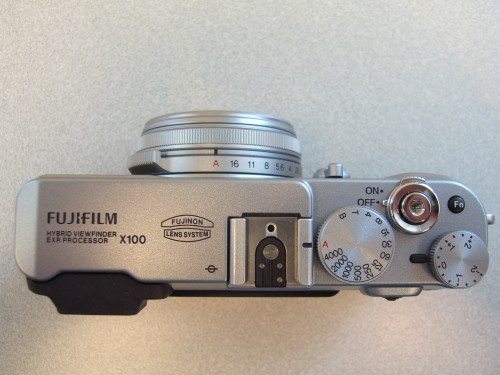
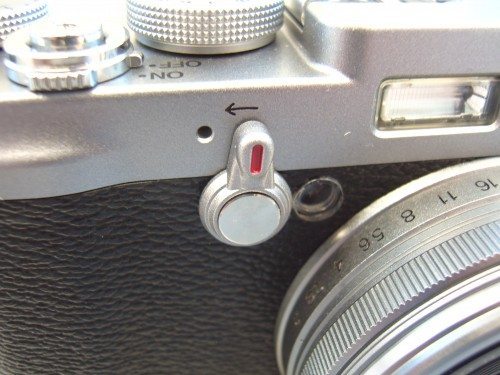
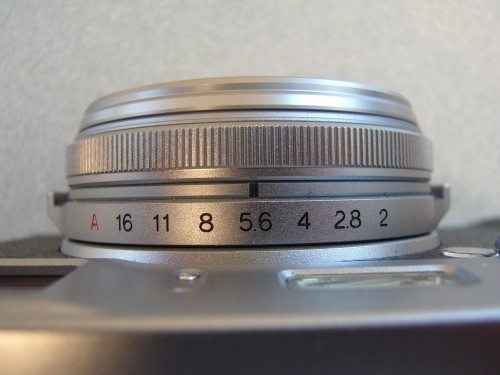
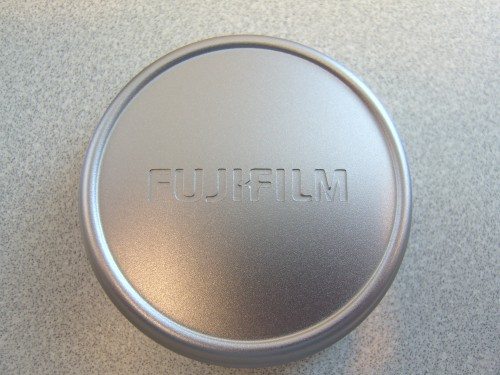
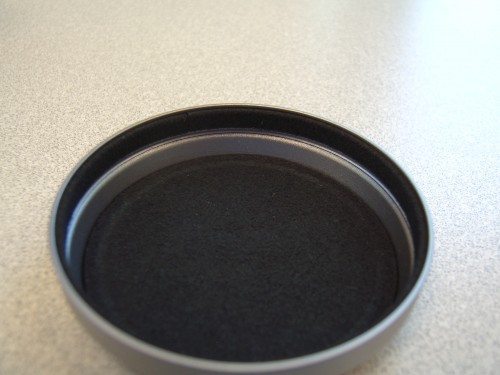
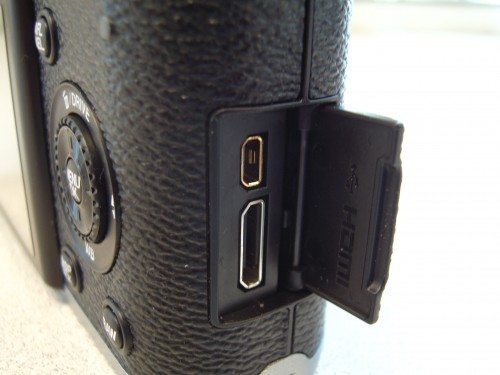

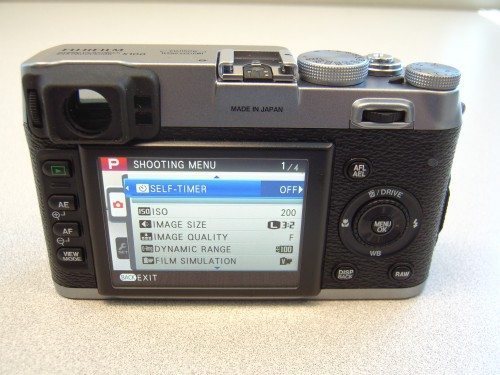
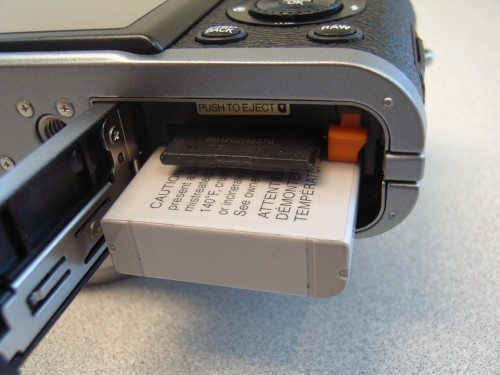
Using the X100, I noticed right away that this isn’t the same as using the crazy, feature-filled pre-programmed digital cameras of today. There are no presets for “action”, “pets” or “aquarium”. There’s not even face detection, which you’d think would be standard in this price range.
I recalled the days before cameras were so automated. I could feel the cobwebs being blown away as my rusty photography skills were reawakened. I guess I really did get lazy!
You still get the standard PSAM modes (Program, Shutter Priority, Aperture Priority, Manual). Leave both shutter and aperture knobs on the red “A” and you’re in full Program mode. Dial in your own shutter speed with aperture on “A”, and you’re in Shutter Priority, and so on.
See that little black “Fn” button? It’s F’n great! You can program it to your own custom function, like ISO, ND filter, etc. Assigning a function is easy, too: Just press and hold the Fn button and it’ll bring you straight to the customize menu.
Let’s talk about that viewfinder. This is no ordinary viewfinder. It’s an optical viewfinder (OVF) and electronic viewfinder (EVF). EVF is straightforward: What you see on the main, rear LCD shows up in the tiny viewfinder. The X100 has a nifty eye sensor (like the ear sensor on an iPhone) that detects your face close by, and toggles the main LCD off as you peek through the viewfinder. (This is user-adjustable if you want to keep things simple).
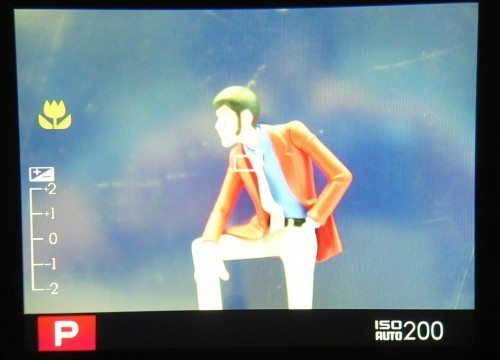
The OVF is a different matter. Yes, you’re looking out the glass, into the “real world”, but the X100 overlays shooting information, like a fighter pilot’s heads-up display. See the two focus points in the middle? The centered one is solid, the off-center one is dashed. When focusing on close-up objects, the focus point ends up being closer to the off-centered one due to parallax. When you lock on to focus, a green square appears on or between the two rectangles, indicating the true focus point. And, the white border around the image also shifts to adjust for parallax.
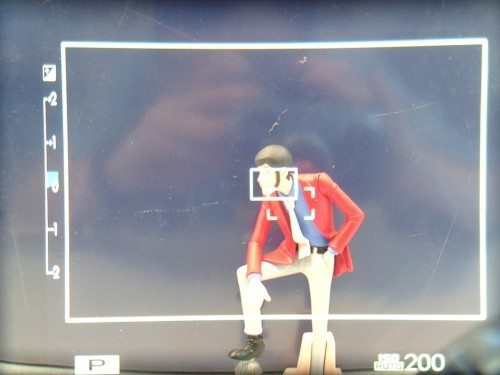
The main LCD is bright and very crisp 2.8-inch, 460,000 dot display. There are many customizations to what you can display, but my favorite has to be the electronic level. I’ve ruined many photos by not watching my horizon and being off-kilter like a vintage Batman episode. The lines turn green when you’re level.
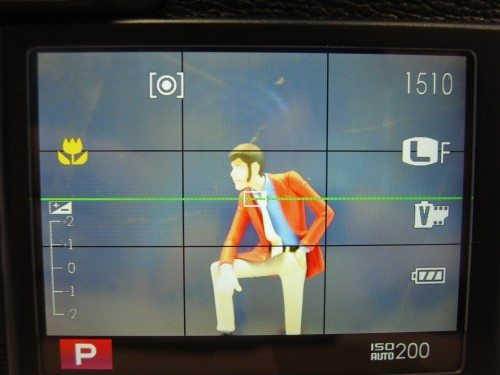
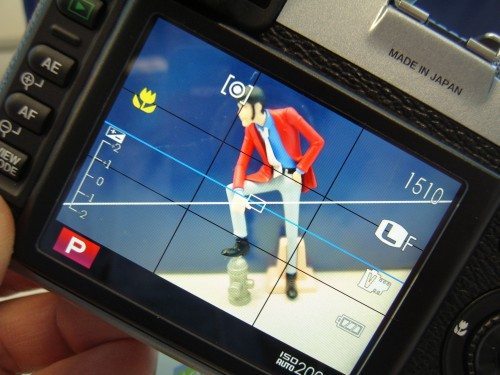
Another interesting feature is the “film” selection. Besides black and white, sepia, and other filtered modes, you can choose between three “film” presets that simulate Fuji’s Provia, Velvia, and Astia films. Provia (“Standard”) is the all-purpose film, Velvia (“Vivid”) gives a more vivid look as the preset suggests, and Astia (“Soft”) gives softer color and contrast.
Film simulation samples
This is picture of a chair in my office. The easiest thing you’ll notice is the blacker blacks and slightly brighter colors on the pillow in the Velvia setting.

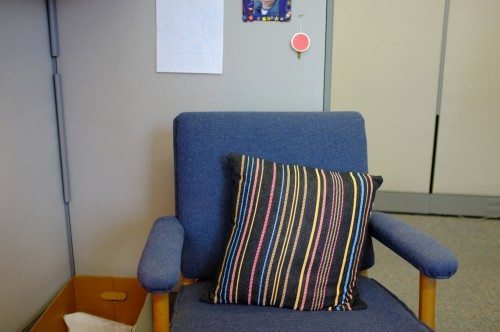

Same thing for these toy cars. With the Velvia setting, the green cars are almost fluorescent, and you can barely see the stripes on the side of the black car.
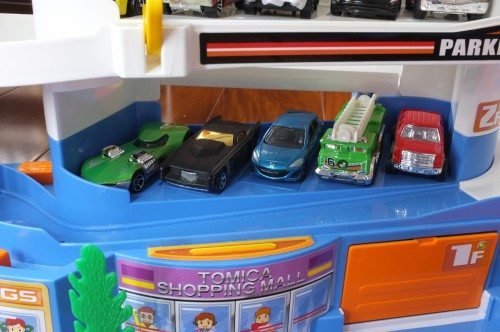
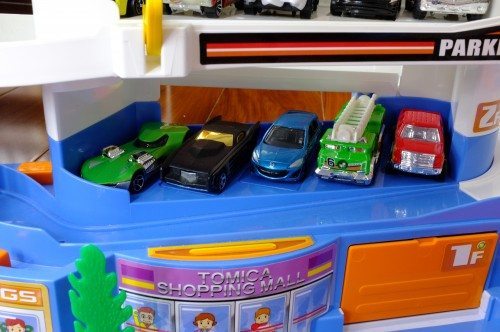
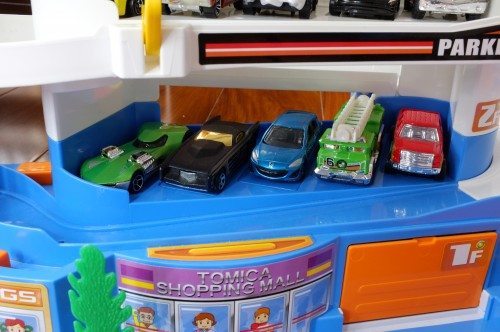
Quirky?
The X100 is not without it’s quirks, though. For one, I find the menu button difficult to press. It’s not small, but it seems flush to the four-way jog dial, so I have to be careful not to make accidental presses.
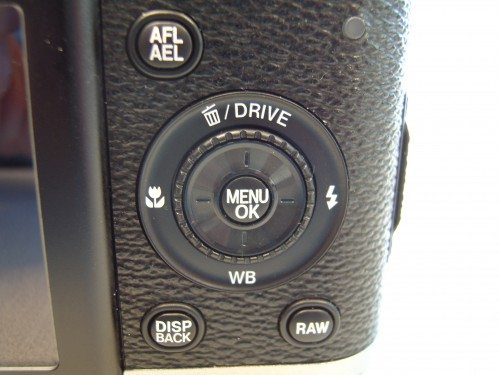
The battery can actually be inserted the wrong way quite easily. I got around this by noticing the battery has an arrow printed on the outside, and that there’s a arrow icon printed on the inside of the battery compartment.
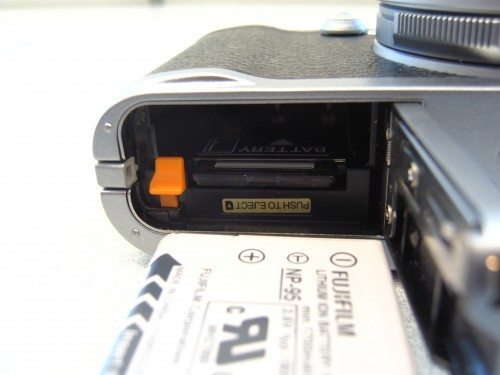
The autofocus/read-write LED is located exactly where you’d put your thumb. Not so hot.

As for manually focusing, forget it. It’s a “focus by wire” setup and there’s no focusing confirmation, like a split prism window or something.
Actual Use:
Without the idiot-proof camera presets, I was more or less forced to think before shooting- as I should have been all along. What kind of effect am I going for? Do I have enough light? That kind of thing. But this is a good thing! Now, when I get a “bad” shot, I blame it on myself and not the camera.
Compared to other point and shoots, the X100 works well in low light where I wouldn’t dream of taking pictures with a point and shoot. This is no surprise, considering the CMOS sensor is way bigger (APS-C) vs. the rinky-dink sensors of most compact cameras.
Yes, there’s no zoom, and there’s no way to change the lens. You’re stuck with what it came with. And, I couldn’t be happier. I’m one of those people who doesn’t like zoom lenses, but that’s just me.
I’ve read reviews that say the camera is slow to startup, read and write. I made sure I used the fastest memory card I could find (this one from Sandisk, a UHS-1 card) and I made sure I formatted it in the camera. No complaints in actual use.
Here are some samples taken on the first week I owned the X100. I’m still getting the feel of things, but I’m happy with the results. Click each image for full size.


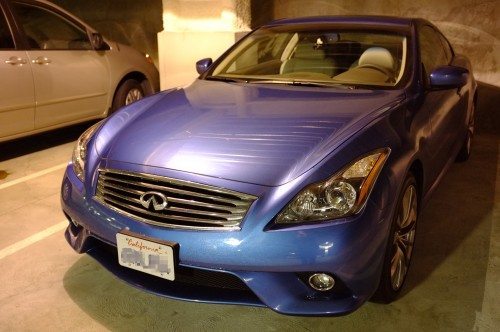
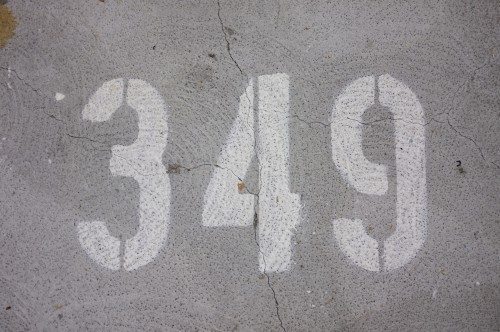
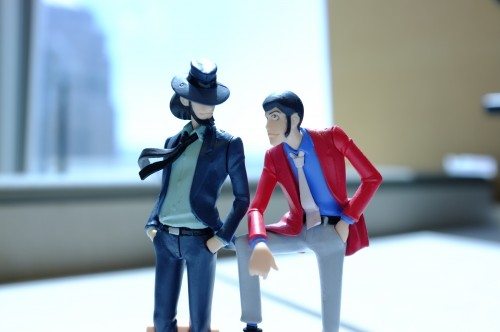
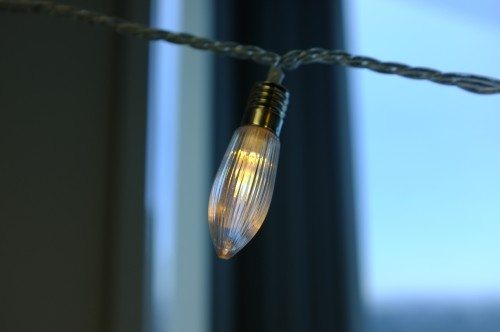

Closing Thoughts:
OK OK I admit. I was initially drawn to the X100 for it’s good looks. But the more reviews I read about it, the more excited I got and I’m not disappointed. No fancy auto-everything presets, but if you take the time to learn the camera and understand (or dust off from memory) the fundamentals of photography, the X100 will reward you with great photos. And in my case, if the shots are bad, it’s entirely operator error!
Are there better cameras that cost less than the $1199 price tag? I’m sure there are. But there aren’t many that can match the sturdy build, good looks, and great performance in such a package smaller than a digital SLR.
SD Card Reader for iPhone iPad, Oyuiasle Digital Trail Camera SD Card Viewer with Dual Slot for MicroSD/SD, Lightening&USBC Dual-Connector Memory Card Adapter for Photography, Plug and Play
$14.99 (as of November 24, 2025 19:01 GMT -05:00 - More infoProduct prices and availability are accurate as of the date/time indicated and are subject to change. Any price and availability information displayed on [relevant Amazon Site(s), as applicable] at the time of purchase will apply to the purchase of this product.)36 Slots Memory Card Case Water-Resistant Anti-Shock Memory Card Wallet for 24 Micro SD SDXC SDHC TF Cards and 12 SD SDXC SDHC Cards
31% OffProduct Information
| Price: | $1199 |
| Manufacturer: | Fuji |
| Pros: |
|
| Cons: |
|


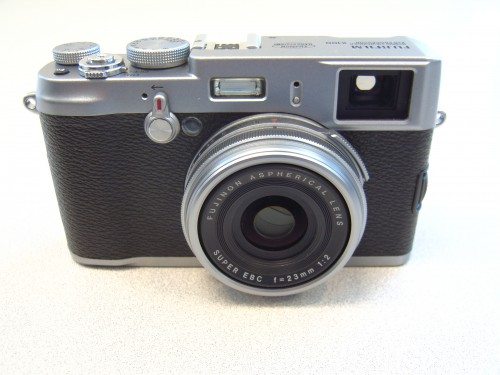
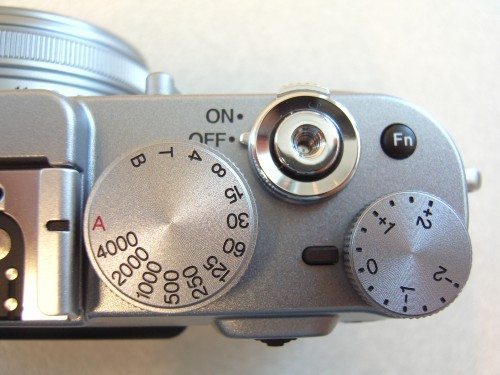
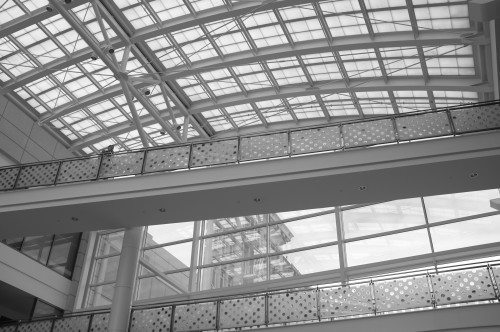
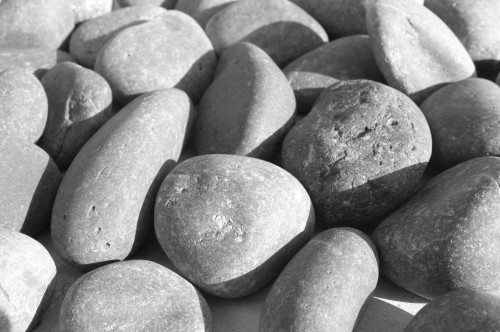



Gadgeteer Comment Policy - Please read before commenting
Hey thanks for the review. I have been using a Canon G9 and I was really frustrated by having to hit various buttons to adjust the apeture or the shutter speed. This camera is very old school letting you dial in both of those items manually and I really like that. I have quite an SLR collection with many great lenses, but like you I was looking for an easy to carry walk around that gives me that manual control I crave. I will have to do some more research on this camera. I do wish it had a zoom personally… not every shot I want to take is a wide angle shot like that. Also, I wish it took RAW format.
The X100 shoots in RAW.
I’ve been using a Fuji X100 for about two months now and love it for a “carry with you” camera that can produce great results. It makes shooting pictures fun and doesn’t seem to spook people on the street, or in a bar or restuarant. I added a Leica strap and can bike with it worn “messenger style” for instant access. I don’t want to fiddle with a lens cap so I use a UV filter plus the lens shade for protection. However, my Nikon D7000 can’t be beat for getting the shot under any circumstances (especially when lighning fast focusing is essential).
Be aware that using the iPad Camera Connection Kit card reader with the X100 can cause the X100 to take 20 to 30 seconds to turn on after file transfer. Flip the read only lever on the card before transfer to prevent the iPad from writng to the card (which confuses the X100). Reset the card for accept writing when returning it to the camera. Formatting the card cures the problem should it occur.
If this had been available when we purchased our Nikon P7000…might have gone with the Fuji.
One thing we did get for the Nikon is this strap:http://www.rainydaymagazine.com/RDM2011/Home/June/Week3/RDMHomeJun1611.htm#Leathinity_CameraStrap
The maker is out of Hong Kong and he makes all of his stuff by hand. It is a great pairing for the Nikon and it would be a good one for the Fuji.
With every review I read about the X100, I fall more in love with it 😀
It’s probably the kind of camera that Lupin would use.
Too bad it’s way outside my budget.
Lupin would use it, if only Fujiko would give it back!
Yes, a very cute camera. Great for family gatherings and some trips. Definitely not a prosumer or pro-quality DSLR. Yes, I want one… but at half the price.
I have this camera for a week now and I think it’s a wonderful tool. Small, lightweight, inconspicuous, good ergonomics and very high quality output. The results are almost as good as from a Nikon D700. Amazing, because the sensor is a lot smaller. Sure, it has some quirks, but I don’t feel that it’s overpriced. For the money you get a good camera and a very good 35mm lens. I hope Fuji will produce a full frame version with a nice set of lenses next year. Could be an attractive alternative for an expensive Leica and a nice addition to the X100.
What an excellent review totally clear and un-confusing in English no jargon. I haven’t purchased this camera yet but studied the images and negative reviews. The lens sharpness is excellent in one of the images and some of the others need the use of a tripod but it’s just a review and as the man says if you take a crap picture it’s you not the camera. All the negatives I read is about user ignorance and un-professionalism, buy the fastest SDHC card format it “as usual”,and off you go puppy. Then the whinge about the price tag, well it’s £700 I’ve found and not bad, then you have to buy a card £17-£30 and case or strap £50-£70 and I’ll pay that,if your poor or lazy you shouldn’t be looking at this beautiful camera and fantastic engineering put in a few more hours make the decision. The image sales from this great camera will pay that off in know time, it’s a pro camera been accepted by getty by the way. The reviews great but the comments so far are so misleading by people who haven’t the foggiest idea about the true photographic world which are dangerous and loose people’s jobs, but what a camera that’s what where hear for!
We have been completely smitten with their X100S. Fuji’s newly announced X-M1 may be more versatile in some respects, but it will be a while before we will be tempted to trade in the X100S.
Here are a few pics of our recent experiences with the X100S in Macro Mode:
http://www.rainydaymagazine.com/RDM2013/Home/June/Week3/RDMHomeJun2113.htm#FujifilmX100s_MacroMode
Click on any of the images for a larger version.
We were particularly impressed with some of the insect shots we were able to pull off. Our next project will be to see if we can get some trickier shots…bees in flight and such.
@Rainy Gorgeous pics!!!!